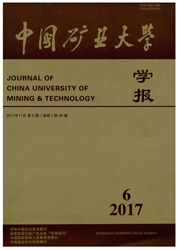

 中文摘要:
中文摘要:
为了揭示流固耦合作用下的煤矿底板陷落柱突水机理,基于破碎岩体渗流理论、固液两相流、地下水动力学等理论,建立了考虑颗粒迁移的陷落柱流固耦合动力学模型.采用理论分析、数值模拟和工程实践相结合的方法对颗粒迁移作用下陷落柱的渗透特性进行了研究,得到了陷落柱孔隙率、渗流速度、孔隙水压力、流体中颗粒体积分数、涌水量等参数随时间变化规律.结果表明:随着时间增加,陷落柱充填颗粒在流固耦合作用下不断被侵蚀成悬浮颗粒并迁移流失,流体中颗粒体积浓度剧增后骤减;陷落柱的整体渗透性起初增加较慢,随着颗粒的不断迁移流失,孔隙率、渗流速度、涌水量快速增大后趋于稳定.
 英文摘要:
英文摘要:
In order to understand the mechanism of Karst collapse columns water outburst un- der the coupled effect of hydro-mechanical, a coupled fluid-solid model is developed by consid- ering particles transport based on theories of broken rock seepage theory, two phase flow of solid-fluid, and underground water dynamics. The seepage characteristics of Karst collapse col- umns with particles transport was investigated by theoretical analysis, numerical simulation as well as engineering practice, and then the variation rule of porosity, seepage velocity, water pressure, particles concentration as well as water inflow volume over time was obtained. The research results indicate that filling material in Karst collapse columns was eroded and trans- ported by water flushing over time. More specifically, particle concentration in fluid increases sharply at the beginning and dramatically dropped at the end; and the seepage ability of Karst collapse columns increases gradually at the beginning, but porosity, seepage velocity, water in- flow volume sharply increases within a short time and then becomes stable.
 同期刊论文项目
同期刊论文项目
 同项目期刊论文
同项目期刊论文
 Mechanical mechanism study on the effect of fully-mechanized mining with filling on key strata defor
Mechanical mechanism study on the effect of fully-mechanized mining with filling on key strata defor Visible-light-induced photocatalytic reduction of Cr(VI) with coupled Bi2O3/TiO2 photocatalyst and t
Visible-light-induced photocatalytic reduction of Cr(VI) with coupled Bi2O3/TiO2 photocatalyst and t 期刊信息
期刊信息
